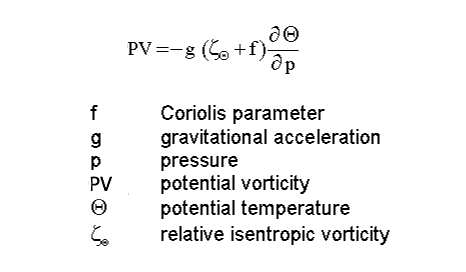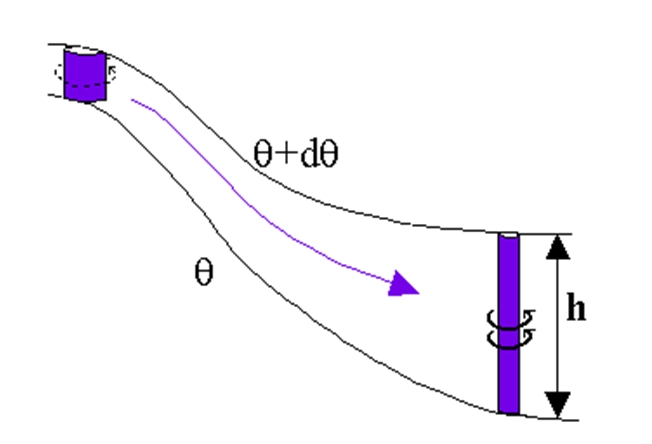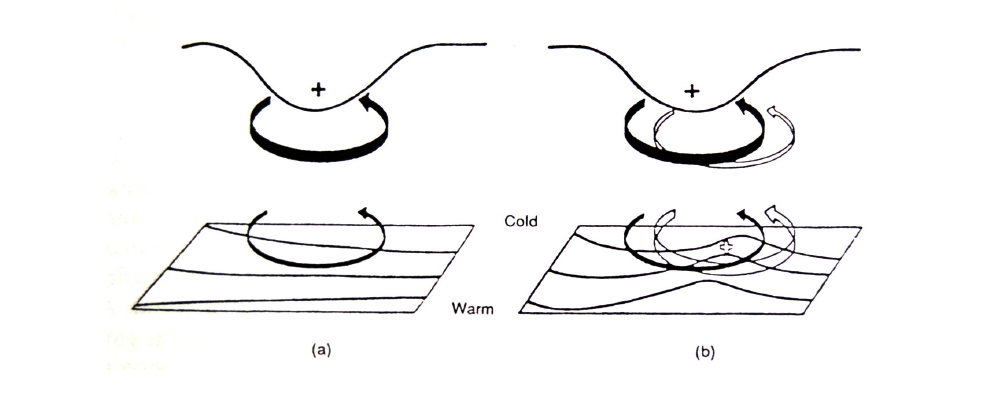The Hoskins theory provides an explanation for the initial perturbation occurring at the intersection of two air masses (e.g. fronts) that leads to cyclogenesis.
Potential vorticity (PV) is the absolute vorticity of an air parcel moving along an isentropic surface. Note from the relation below, that PV is simply the product of absolute vorticity on an isentropic surface (ζθ + f) and static stability (∂θ/∂p). Hence, PV consists of two factors, a dynamic and a thermodynamic part:
It is of importance to know that the PV of an air parcel is conserved when the parcel moves along an isentropic surface on its way through the atmosphere. This condition is usually fulfilled, when we omit diabatic processes and turbulent mixing in the atmosphere. Under these assumptions, we can state that
PV = const.
for any air parcel in the upper troposphere moving along isentropic surfaces.
Under stable conditions, isentropic surfaces are closer to each other than under unstable conditions. The former is the case near the tropopause, where the atmosphere is very stable. When static stability decreases, for example when air moves to lower atmospheric levels with less stability (e.g. at a tropopause fold), vorticity increases (see figure 1) because absolute vorticity and static stability are coupled due to the conservation of PV.
Figure 1: Illustration on how rotation (vorticity) increases when the air column gets stretched.
Cyclogenesis at lower levels is induced by air masses with high values of PV being advected from the tropopause towards lower atmospheric levels over a region with a pre-existing meridional temperature gradient (e.g. a baroclinic boundary). An explicit example showing this interaction are cases of Rapid Cyclogenesis where PV - anomalies play a major role in their rapid or even explosive development.
In such a case, as shown schematically in figure 2, the circulation induced by the upper-level PV anomaly leads to a temperature advection near the surface and upper-level PV - anomalies can become locked in phase, so that the induced circulations produce a very rapid amplification of the anomaly pattern.
Figure 2: A schematic picture of cyclogenesis associated with the arrival of an upper-level vorticity anomaly. (a) The low-level cyclonic vorticity induced by the upper-level vorticity anomaly. The circulation induced by the vorticity anomaly is shown by the solid arrows, and potential temperature contours are shown at the lower boundary. The advection of potential temperature by the induced lower-level circulation leads to a warm anomaly slightly east of the upper-level anomaly. This in turn will induce a cyclonic circulation as shown by the open arrows in (b). The induced upper-level circulation will reinforce the original upper-level anomaly and can lead to amplification of the disturbance. © Holton, 1992.


